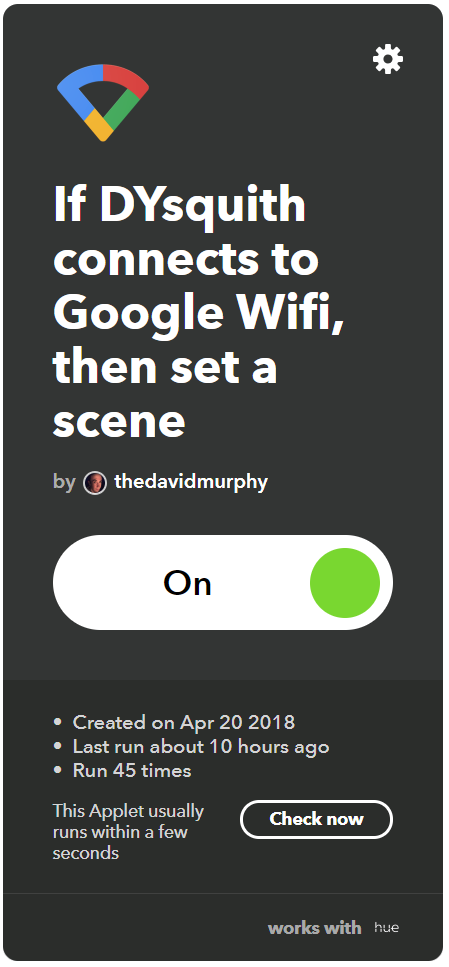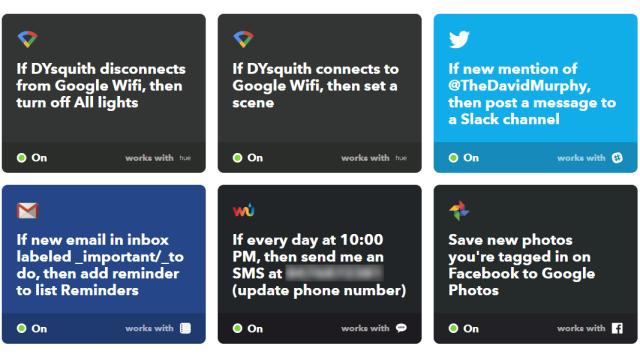I love automation; I do. I just think it’s the most fun thing ever to walk into my house and have my smart lights immediately pull up some colourful scene — not to mention all the absurd configurations I can create that changes their colours and brightness when certain things happen, ranging from “I got a tweet” to “It’s midnight why are you still awake go to bed.”
Screenshot: David Murphy
Prior to Lifehacker, I spent years reviewing wireless routers, but I never had the chance to find out what it’s like to connect one to IFTTT until recently. And now that I have, I don’t think I want to use one that can’t.
IFTTT isn’t the most comprehensive service ever, but it sure is fun
If you haven’t heard of IFTTT (If This, Then That), here’s a quick primer. The online tool allows you to connect different apps and services to one another. So, if something happens in one — someone mentions you in a tweet, for example — then you can trigger something to happen in another, like flipping on a smart switch connected to a nearby lamp. It’s a silly example, but IFTTT gives you plenty of possibilities for triggers and actions.
You can use your device’s location services to trigger hardware and services to perform actions whenever you arrive or leave your house — turning on a ceiling fan when you get home, for example. I find that it’s even more convenient to have these actions trigger when you connect or disconnect from your wireless network.
[referenced url=”https://www.lifehacker.com.au/2017/10/the-beginners-guide-to-ifttt/” thumb=”https://i.kinja-img.com/gawker-media/image/upload/t_ku-large/ujsyahfeoicem9jejyh2.png” title=”The Beginner’s Guide To IFTTT” excerpt=”If you think back to your high school geometry class, you might remember that “If/Then” statements were used in solving mathematical proofs. But even if maths wasn’t your thing, you actually use If/Then statements every day. “If it’s raining outside, then I will bring an umbrella.” Or, “If I eat this doughnut, then I will be very guilt- um, happy.””]
Here’s my setup: I have a bunch of Philips Hue lights in my room, and I like having them switch to a dim setting when I come home because I’m too lazy to hit the nearby Hue Tap (or pull out my phone and trigger a scene manually). Though Hue’s iOS app can trigger scenes when it detects you arrive or leave a particular geofence, that imaginary circle around my house isn’t as tight as I’d like.
Whenever I’d use location-based triggers in my Hue app, I’d often find that I’d leave my house — which would automatically flip my lights off — then accidentally trigger the “turn on” action when driving by on a nearby freeway.
Hue, it seems, often thought that I entered my invisible “I’m home” bubble. Then, for whatever reason, my lights would just stay on — perhaps Hue was having a bit of a headache when I quickly entered and left the geofence.

Screenshot: David Murphy
No matter the reason, the outcome was annoying: my lights would be on for hours when I wasn’t home, the exact situation I was trying to avoid when setting up convenient “when you arrive / when you leave” actions.
Now that I’m playing around with a Google Wifi — which can connect to IFTTT — I love that I can make actions trigger when certain devices connect or leave my wireless network. In my case, I now have my room’s lights flip on and off when my phone hops on and off my wi-fi. (I even have a little notification running in the IFTTT app to let me know when this happens, to keep it honest and ensure my lights don’t stay on all weekend if I’m out of town.)
That said, there’s plenty more I could do with the trigger: post “I’m home!” twitter messages, prioritise certain devices when they connect to my Google Wifi, set a particular temperature on our house Nest when a device connects, play a song from a nearby Android device whenever another device connects, et cetera. There are a lot of options to play with — many of them silly, but still fun to explore.
Does your router support IFTTT?
I’m lucky, in that it couldn’t be any easier to get Google Wifi working with IFTTT. Other manufacturers like TP-Link, ASUS, and Netgear (sort-of) have some routers that support IFTTT, but it’s not a guarantee for every router.
Not only is it doubtful that your three-year-old router is going to get any kind of firmware upgrade to make it work with the service, but it’s the exception, not the rule, that newer routers support IFTTT.
And that’s a shame. While the service isn’t perfect — I still can’t trigger Google Wifi to blast The Final Countdown from my Google Home whenever I come in the door — it’s still great for some aspects of home automation. Though I have other, more powerful routers I could set up instead of Google Wifi (I shake my head at AC1200), they don’t support IFTTT, and it’s just way, way too convenient to make rules around wireless access than location.
In a perfect world, router manufacturers would allow you to tie every hardware product to an online account, and you could then use that online account with other connected services to expand your home’s functionality in new and exciting ways.
We aren’t quite there yet — and I’m hoping we reach that point someday, especially as mesh networking grows in popularity. (It felt like it took forever just to move from complicated, web-based router UIs to easy-to-use setup apps.) I just want to make my house do stupid things whenever I get home. Is that so much to ask?

Comments